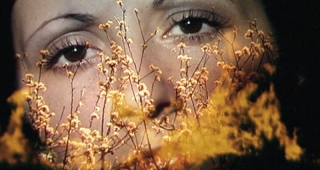Date: 31 October 2004 | Season: London Film Festival 2004 | Tags: London Film Festival
THROW YOUR WATCH TO THE WATER
Sunday 31 October 2004, at 7pm
London National Film Theatre NFT3
Eugeni Bonet, Tira Tu Reloj al Agua (Throw Your Watch to the Water), Spain, 2004, 91 min
José Val del Omar (1904-82), one of the pioneers of European avant-garde film, remains virtually unknown outside of Spain. His visionary Triptico Elemental de España (1953-61) embodies the soul, landscape and diverse cultural mix of his Andalucian homeland, connecting life on our planet with the elementary forces of the universe. Using material shot by the film-maker between 1968-82, Eugeni Bonet has assembled Throw Your Watch to the Water, whose images, ranging from documentary to complete abstraction, mark the passage from the earthly world to a transcendental plane. The film opens in the Alhambra, detailing the intricate Moorish architecture, pulsing fountains and activities of the local people. The ancient citadel, at first serene and regal, is overrun by the transparent bodies of tourists, whilst the ‘videoterrorifico mirror’ of television reflects the frenzy of modern media. Val del Omar envisaged a ‘cinematic vibration’ that would be the vertex of his life’s work, and this film, in which images and thoughts flow free of time, is a meta-mystical allegory that seeks a unity between the spiritual realm, the ancient world and contemporary life.
Also Screening: Saturday 30 October 2004, at 8:30pm, London ICA2
PROGRAMME NOTES
THROW YOUR WATCH TO THE WATER
Sunday 31 October 2004, at 7pm
London National Film Theatre NFT3
TIRA TU RELOJ AL AGUA (THROW YOUR WATCH TO THE WATER)
Eugeni Bonet, Spain, 2004, 35mm, colour, sound, 91 min
Despite a circle of admirers that includes the directors Chris Marker and Victor Erice, José Val del Omar (1904-1982), one of the pioneers of European avant-garde film, remains virtually unknown. In pursuing his dream for a cinema for all the senses he made numerous technical innovations and discoveries, and patented designs for cinematic surround sound, wide-screen projection and special lenses years before they became commonplace.
His career began in the 1920s with dozens of ethnographic films made for the Misiones Pedagógicas. Focusing on the impoverished regions of Spain, the surviving examples are reminiscent of the stark, early documentaries of Luis Buñuel.
Throughout the 1950s he worked on the Triptico Elemental de España, consisting of three short 35mm films that each characterised one of the elements: water (Aguaespejo granadino, 1953-55), fire (Fuego en Castilla, 1958-60) and earth (Acariño galaico, 1961). Val del Omar was fundamentally connected to the soul, landscape and culture of his Andalucian homeland, and these films embody its diverse cultural history, referencing Christian and Islamic beliefs, and the connections between life on our planet and the universal whole. There are some similarities with the trance films of Anger, Brahage, Deren and Markopoulos, though Val del Omar’s methods are overtly mystical and cosmic. Throw Your Watch to the Water has been assembled by Eugeni Bonet, working with the Archivo María José Val del Omar and Gonzalo Sáenz de Buruaga, to realise a work that occupied the film-maker for decades up until his sudden death in a car accident.
The film is set in Granada, an extraordinary location where east meets west. It opens with footage of the Alhambra and its surroundings, detailing the extraordinary Moorish architecture and intricate decoration, the pulsing water of its fountains and the activities of the local people. The ancient citadel, shown at first serene and regal, is later overrun by the transparent bodies of tourists, while the ‘videoterrorifico mirror’ of television reflects the frenzy of modern media.
These ‘variations on an intuited cinegraphy’ have been created entirely from material shot by Val del Omar between 1968-82. The newly commissioned atmospheric score is punctuated by his poetic declarations which invite comparison with both Federico García Lorca and Sun Ra.
Val del Omar envisaged a “cinematic vibration” that would be the vertex of his life’s work, a development and elaboration of the ‘Elementary Triptych’ in which he first presented his radical cinematic visions. The passage of images, which ranges from documentary to complete abstraction, is exquisitely photographed in lush colours and tonal monochromes. Delirious visual sequences mark the passage from the earthly world to a transcendental plane. The film is a meta-mystical allegory of life, death and rebirth led by the elementary forces of the universe, seeking unity between the spiritual realm, the ancient world and contemporary life, where images and thoughts flow free of time.
(Mark Webber)
Back to top
